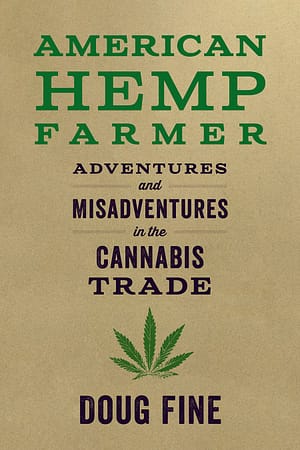Hemp Can Do That: The Forgotten History of Hemp Cultivation

The stat sheet on hemp sounds almost too good to be true: its fibers are among the planet’s strongest, its seed oil the most nutritious, and its potential as an energy source vast and untapped.
Our extensive use of hemp may seem like a hot new trend, but hemp is actually inextricably intertwined with human history. In Doug Fine’s own words “Seventy-seven years of cannabis prohibition, in other words, are a blip in humanity’s eight-millennia relationship with this plant.”
The following is an excerpt from American Hemp Farmer by Doug Fine. It has been adapted for the web.
If we attempt to pinpoint why hemp is about to become the fastest agricultural industry ever to reach a billion dollars in annual sales, it might be because humans have an embedded genetic memory about the plant.1 Hemp has been a “camp follower” crop, say anthropologists, since before the arguable misstep of sedentary agriculture.2 Michael Pollan argues in The Botany of Desire that we actually co-evolved with cannabis and other plants. To him it just makes Darwinian sense—if a plant wants these apes to keep carrying and planting it around the planet, that plant will do its best to give them things they want: roofs, sandals, superfood, party favors. Not bad from one seed.
In an era when any material is a click away, I utilize hemp every day, strictly for performance reasons—it beats the competition: might be the plant’s seed, fiber, or flower. Often all three. I eat it, wear it—I’m about to patch my porch with a homegrown hemp fiber plaster. My laptop case is made of hemp fiber, too—I like to think hemp’s microbial-balancing properties protect me from disgusting airplane tray tables.

Put simply, these receptors prepare our bodies to receive the properties of cannabinoids. You can think of them as Velcro, waiting for, say, the pain-relieving components of cannabis to be introduced when we bark our shin. All mammals, amphibians, reptiles, birds, and fish have endocannabinoid systems. There’s preliminary research into whether some invertebrates also have them.3 If they do, that sure dates our relationship with the cannabis plant way back in history.
Modern farmers reveal their encoded love for hemp without always realizing why. When my Kentucky colleague Josh Hendrix took me to an antebellum barn that sported a World War II–era hemp brake used to prepare rope for navy rigging, he demonstrated the recently rediscovered, calf-sized wooden device as though he had been using it for years.
“Hemp is deeply rooted in rural Kentucky culture,” he told me.
“Most people would call this a tobacco barn. But before that it was a hemp barn.”
Seventy-seven years of cannabis prohibition, in other words, are a blip in humanity’s eight-millennia relationship with this plant.
From an economic standpoint, said Steve DeAngelo, a prominent cannabis activist since the 1970s, “the cannabis industry’s sustained double-digit growth curve is almost unprecedented in modern business history, and that’s before the whole plant is legalized federally.” The phenomenon he describes is not limited to North America—a Moroccan farmer named Adebibe Abdellatif flew halfway across the globe on his own dime to attend a 2017 United Nations cannabis session, where he told me his motivation was to ensure that the global hemp reemergence “is steered from the farm.”
DeAngelo cofounded the Harborside nonprofit dispensaries (originally Harborside Health Center) in California in 2006, and is in a unique position to characterize the industry’s growth curve. “Because of its breadth of applications, cannabis/hemp is the most disruptive economic development since Silicon Valley edged out blue chips,” he told me.
“To say we’re in our infancy is an understatement when it comes to this plant’s uses and markets.”
The biggest driver of hemp since (and only since) the first research only Farm Bill has been cannabidiol, popularly known as CBD. The market for this valuable, hemp-flower-derived nutritive supplement and topical application is growing 23 percent annually, and is on its way to being firmly established in the healthy person’s wellness lexicon, the way that omegas and aloe are.
- Phil Buck, “Florida Cannabis Director: Hemp Will Be a Billion-Dollar Industry for State,” WTSP News, March 7, 2019, https://www.wtsp.com/article/news/florida -cannabis-director-hemp-will-be-a-billion-dollar-industry-for-state/67-98b873 cf-4b6b-4061-86de-d4450a550ab0.
- Ernest Small and David Marcus, “Hemp: A New Crop with New Uses for North America,” in Trends in New Crops and New Uses, eds. Jules Janick and Anna Whipkey (Alexandria, VA: ASHS Press), 284–326.
- M. Salzet and G. B. Stefano, “The Endocannabinoid System in Invertebrates,” Prostaglandins, Leukotrienes and Essential Fatty Acids 66, nos. 2–3 (February 2002): 353–61, https://doi.org/10.1054/plef.2001.0347.
Recommended Reads
Recent Articles
Oxeye daisies are one of the most important plants for pollinators including beetles, ants, and moths that use oxeye daisies as a source of pollen and nectar. Instead of thinking about removing a plant like oxeye daisy, consider how you can improve the fertility and diversity of habitat resources in your home landscape, garden, or…
Read MoreSo you want to start reaping your harvest, but you’re not sure where to start? Learn how to break down the options of harvesting tools!
Read MoreWhat’s so great about oyster mushrooms? First, you can add them to the list of foods that can be grown indoors! They are tasty, easy to grow, multiply fast, and they love a variety of substrates, making oyster mushrooms the premium choice. The following is an excerpt from Fresh Food from Small Spaces by R. J.…
Read MoreEver heard the phrase, “always follow your nose?” As it turns out, this is a good rule of thumb when it comes to chicken manure. Composting chicken manure in deep litter helps build better chicken health, reduce labor, and retain most of the nutrients for your garden. The following is an excerpt from The Small-Scale Poultry…
Read More








